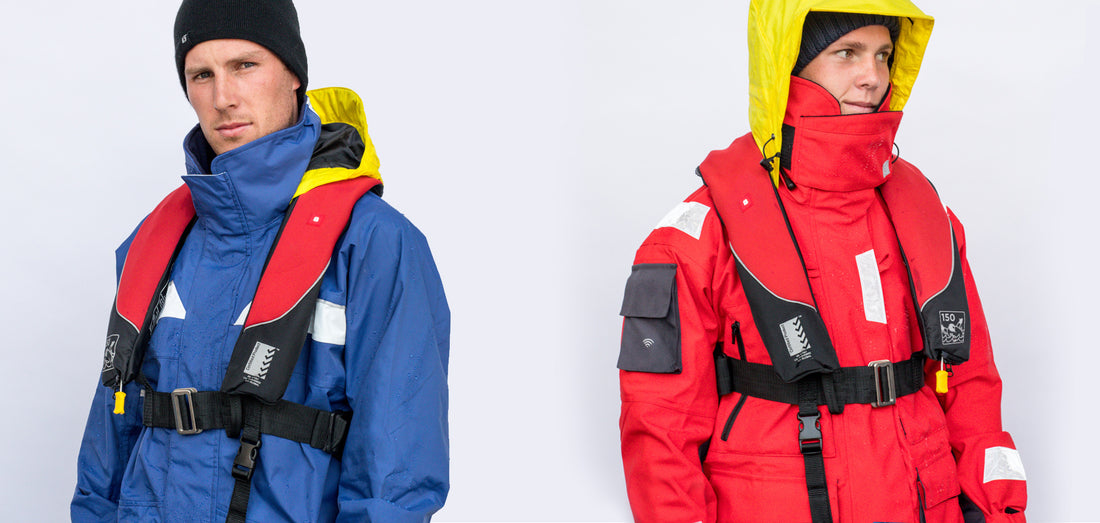As the old adage goes, the best PFD (personal flotation device) is the one you’re wearing. But when it comes to inflatable PFDs, the debate is far from settled as to whether manual or automatic is the way to go.

“When choosing a life jacket, you should always consider how and where it is to be used,” says Burke Marine's Ryan O'Donnell.
“We never recommend a type of PFD or activation; what we do always recommend is that everyone should do their own risk assessment—carefully,” he says.
Ryan says a thorough risk assessment should include (but is not limited to) how good a swimmer you are, how likely you are to be on deck alone, whether the type of vessel you sail is prone to capsizing or keel problems, the water temperature you sail in (water colder than 15˚C can instigate cold water shock, rendering a casualty incapable), and how likely you are to suffer a fall or get knocked down, either due to age or lack of balance.

“If you're quite strong with good balance, a strong swimmer and competent sailor, you could choose a manual inflation life jacket."
"If you're not a confident swimmer, not very strong and prone to panic we'd probably insist on an auto inflate model."
"There are also options to change automatic models to manual with either a blanking cap or sealing cap. This way you can adjust your PFD to suit different scenarios” he says.
Here, we take a look at how inflatable vests work and the pros and cons of both manual and automatic PFDs.
How inflatable PFDs work
Every inflatable PFD has an inflator mechanism that triggers a carbon dioxide cylinder to fill the bladder with air. Manual PFDs inflate when you pull the “jerk tab,” a yellow handle that dangles at approximately waist height, which pierces the CO2 cylinder. An automatic PFD will inflate when the water-sensing cartridge comes in contact with water releasing a spring-loaded pin that punctures the CO2.

There are four ISO levels for PFDs: 50, 100, 150, and 275 newtons of buoyancy.
The ideal amount of buoyancy for offshore sailors is 150 newtons. PFDs with 50 or 100 newtons are for use in sheltered waters where rescue is close at hand while 275 newton models were designed for use by the oil and gas industry for workers wearing or carrying heavy clothing and tools.
Inflatable PFDs are also designed to right a wearer who is face down, putting them onto their back so that they can breathe.
The pros and cons of automatic inflate
Automatic inflation occurs when the PFD gets wet, so if the user is incapable of activating in a timely fashion the device will still inflate and support. Many people say this is advantageous if knocked unconscious, but the real advantage is due to incapability caused by cold water shock.
“If you are unconscious in the water and being supported by a life jacket in any kind of seaway, it is unlikely that you will not ingest water into your lungs and drown,” says Ryan. “Using a PFD at sea requires the deployment of a spray hood or holding both hands cupped together over the mouth and nose to enable breathing without seawater entering the lungs. An unconscious person is supported by an auto inflate PFD but cannot perform these acts to ensure survival.”
The pros and cons of manual inflate
“When using a manual inflate live vest, the wearer has complete control over the inflation of the PFD and chooses when to inflate it, reducing the possibility of unwanted inflation or entrapment,” says Ryan.
"There is absolutely no chance of a manual inflate vest going off when you don’t want it to, so if you sail a small boat like a J/70 or in an area with regular rain showers, manual maybe be the way to go. Also, manual inflate PFDs generally require less servicing than auto-inflate vests."
However, in order for the vest to inflate, the wearer must be conscious and physically capable of pulling the cord. Manual inflate vests are not recommended for people who don’t know how to swim or for children under 16.

The great debate
Another drawback to the auto inflate PFD is the rare occasion where you’re in a serious boating accident and you find yourself trapped under the upturned hull and unable to get out because you’re life jacket has inflated. Your only options to get out are to take the vest off (not recommended) or to deflate the vest using the valve, swim out, and then manually blow it back up again (highly taxing).
However, it’s important to know that while manual vests can’t be converted to automatic, automatic vests CAN be converted to manual inflate using a blanking cap or sealing cap. It’s not something that can be done on the fly, but it isn’t very difficult either, and the automatic to manual switch could be achieved if building conditions suggest it would be a good idea.
Other things to consider
Whichever type of activation you chose for your PFD, “it will be of little use if it is not fitted with a strong harness, a spray hood, and crucially a crutch strap,” Ryan says. A tether, water-activated light, reflective markings or tape, a whistle, and safety knife should also be attached to it, as well as a PLB, EPIRB or SART in some cases.


